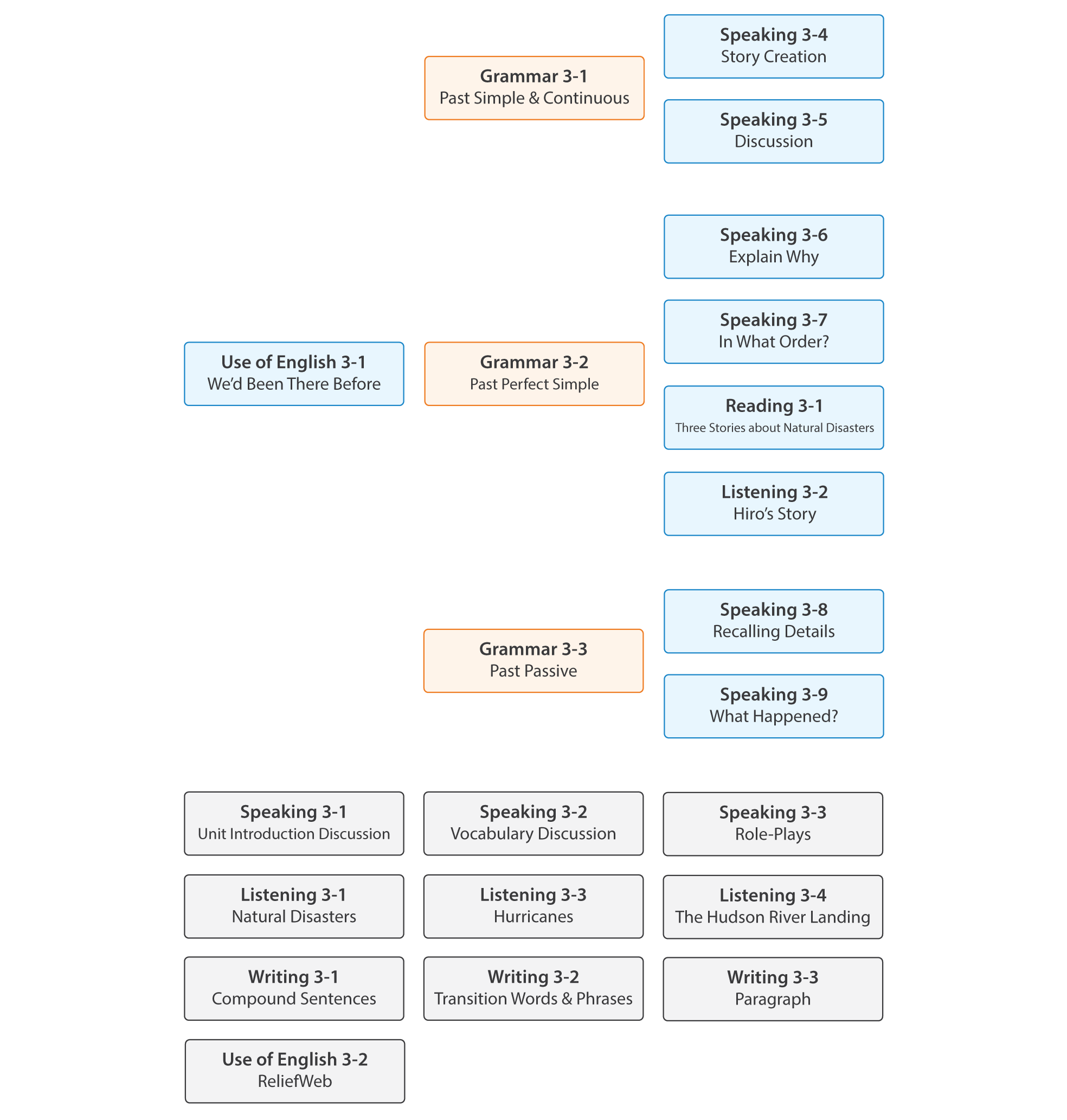| Unit Objectives | |||
|---|---|---|---|
Forces of NatureStudents use and are exposed to vocabulary in order to describe subjects related to extreme weather conditions, aviation and natural disasters. |
Describing Past Events & StoriesStudents study the Past Simple, Past Continuous, and Past Perfect Simple tenses in the context of narrating both simple past events and longer and detailed stories. |
Compound SentencesStudents are introduced the basic mechanics of writing compound sentences. |
TransitionsStudents learn how to use different kinds of transitions to effectively organize ideas when writing. |

| Listening | Speaking | Grammar |
|---|---|---|
3-1 Natural DisastersActivity based on recording of several people describing experiences with natural disasters. Activity reinforces student understanding of unit vocabulary. 3-2 Hiro's StoryGrammar-based listening activity serving as a comprehension-check of the past tenses. Activity is based on one man's story of surviving the Japan earthquake and tsunami of 2011. 3-3 HurricanesActivity based on one man’s description of his experience with a hurricane. Activity contains several unit vocabulary words. 3-4 The Hudson River LandingActivity based on the landing in the Hudson River by the US Airways Flight 1549 in 2009. |
3-1 Unit Introduction DiscussionUnit introduction conversation activity. 3-2 Vocabulary DiscussionVocabulary discussion activity. 3-3 Role-PlaysStudents improvise dialogues according to prompts. 3-4 Story CreationStudents work in groups and prompt each other in an effort to orally recite stories in the past simple and continuous tenses. 3-5 DiscussionStudents discuss answers to questions that focus on the use of the Past Simple and/or the Past Continuous. 3-6 Explain WhyStudents work with a partner and give fictional reasons for doing things in the past. Activity targets the use of the Past Perfect Simple. 3-7 In What Order?Students work with a partner and use the Past Perfect Simple to figure out the order in which their partner did activities listed on their page. 3-8 What Happened?Students read short stories to their partner and then quiz them on their comprehension targeting responses in the passive voice. |
3-1 The Past Simple & ContinuousStudents review and reinforce their comprehension of the past simple and continuous tenses. Page also covers the rules along with several audio examples of the three ways to pronounce “...ed” in past forms of regular verbs. 3-2 Past Perfect SimpleStudents learn the meaning, form, and usage of the past perfect simple tense and its role in narration. 3-3 Past PassiveStudents practice using the three tenses studied in Unit 3 in the passive voice. |
| Reading | Use of English | Writing |
|---|---|---|
Reading 3-1 Three Stories about Natural DisastersReading activity containing examples of unit grammar and vocabulary. |
3-1 We'd Been There BeforeFour short conversations that serve as a lead in to Grammar 3-2. 3-2 ReliefWebStudents use ReliefWeb.int, a digital service provided by the United Nations, to learn about areas of the world experiencing problems with natural disasters. |
3-1 Compound SentencesStudents learn how to write compound sentences. 3-2 Transition Words & PhrasesThis lesson focuses on linking devices used to connect ideas between sentences or within compound sentences. Students practice using these transitions. 3-3 ParagraphStudents write a paragraph describing a natural disaster. |
| Vocabulary | |||
|---|---|---|---|
|
accident airline assemble aviation belly-landing bomb charter chief CAT climb crash crosswind |
disaster earthquake emergency engine fire firefighter flameout flight flight plan flock foam hijack |
hurricane ident investigate landing length mountain prop radar ramp remote rescue retardant |
runway severe site take-off TSB tsunami typhoon V1 VFR VHF wind shear |